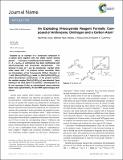An exploding N-isocyanide reagent formally composed of anthracene, dinitrogen and a carbon atom
Author(s)
Joost, Maximilian G; Nava, Matthew Jordan; Transue, Wesley; Cummins, Christopher C
Downloadan_exploding.pdf (2.137Mb)
OPEN_ACCESS_POLICY
Open Access Policy
Creative Commons Attribution-Noncommercial-Share Alike
Terms of use
Metadata
Show full item recordAbstract
Targeted as an example of a compound composed of a carbon atom together with two stable neutral leaving groups, 7-isocyano-7-azadibenzonorbornadiene, CN[subscript 2]A (1, A = C[subscript 14]H[subscript 10] or anthracene) has been synthesized and spectroscopically and structurally characterized. The terminal C atom of 1 can be transferred: mesityl nitrile oxide reacts with 1 to produce carbon monoxide, likely via intermediacy of the N-isocyanate OCN[subscript 2]A. Reaction of 1 with [RuCl[subscript 2](CO)(PCy[subscript 3])[subscript 2]] leads to [RuCl2(CO)(1)(PCy3)2] which decomposes unselectively: in the product mixture, the carbide complex [RuCl[subscript 2[](C)(PCy[subscript 3])[subscript 2]] was detected. Upon heating in the solid state or in solution, 1 decomposes to A, N2 and cyanogen (C2N2) as substantiated using molecular beam mass spectrometry, IR and NMR spectroscopy techniques.
Date issued
2017-10Department
Massachusetts Institute of Technology. Department of ChemistryJournal
Chemical Communications
Publisher
Royal Society of Chemistry
Citation
Joost, Maximilian, et al. “An Exploding N-Isocyanide Reagent Formally Composed of Anthracene, Dinitrogen and a Carbon Atom.” Chem. Commun., vol. 53, no. 83, 2017, pp. 11500–03.
Version: Author's final manuscript
ISSN
1359-7345
1364-548X